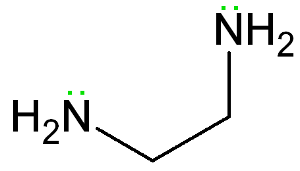A ligand is an ion or molecule that binds to a central metal atom to form a complex (alternatively known as a coordination entity).

Ligands are usually thought of as electron donors attracted to the metal at the center of the complex. Metals are electron acceptors.
Ligands may be neutral or negatively charged species with electron pairs available. Water is a common ligand. Here a water molecule is shown with its two lone pairs of electrons.

An electron pair from the ligand, such as water, provides both of the electrons for the bond that forms between itself and the central metal atom or ion.
Here a single ligand L, which could be water, donates a pair of electrons to form a bond with a metal atom M.
Monodentate Ligands
Monodentate ligands have only one atom capable of binding to a central metal atom or ion.
H20 and NH3 are examples of neutral monodentate ligands.
When H20 is a ligand, oxygen is the donor atom binding to the metal. When NH3 is a ligand, nitrogen is the donor atom binding to the metal.
Examples of electrically charged monodentate ligands are halide ions, such as: F-, Cl-, Br-, I-, and cyano, CN-.
The overall charge on a complex is the arithmetic sum of the oxidation state of the metal in the center plus the charge(s) brought to the complex by each ligand.
For example, if a complex forms between Fe2+ and six CN- ligands, the complex will have a -4 charge, and the formula is written [Fe(CN)6] 4-.
Polydentate Ligands
 Example of a bidentate ligand. Ethane-1,2-diamine has two lone pairs of electrons shown in green.
Example of a bidentate ligand. Ethane-1,2-diamine has two lone pairs of electrons shown in green.
A ligand molecule with more than one donor atom is a called a polydentate ligand. These are given specific names, depending on how many donor atoms they contain.
Bidentate Ligands
Bidentate ligands have two atoms capable of binding to a central metal atom or ion.
Ethane-1,2-diamine (shown in the image) is an example of a bidentate ligand.
Both of the nitrogens in this molecule can act as electron donors, binding with a central metal atom or ion.
Other examples of bidentate ligands are the acetylacetonate ion, known as (acac), and the oxalate ion (ox).
 Example of a tridentate ligand. 1,4,7-triazaheptane (also known as diethylenetriamine) has three lone pairs of electrons shown in green.
Example of a tridentate ligand. 1,4,7-triazaheptane (also known as diethylenetriamine) has three lone pairs of electrons shown in green.
Tridentate Ligands and Higher Polydentate Ligands
Tridentate ligands have three atoms capable of binding to a central metal atom or ion.
Molecules with four donor atoms are called tetradentate ligands; five donor atoms, pentadentate; and six donor atoms hexadentate.
A complex that contains a polydentate ligand is called a chelate.
The image shown below of EDTA binding to a central metal atom is an example of a chelate. Also, see crown compounds.
 Example of a hexadentate ligand. EDTA (also known as ethylenediaminetetraacetic acid). The image shows a complex formed between EDTA and a central metal species.
If the metal were Fe in oxidation state III, the complex would be [Fe(edta)] -
Example of a hexadentate ligand. EDTA (also known as ethylenediaminetetraacetic acid). The image shows a complex formed between EDTA and a central metal species.
If the metal were Fe in oxidation state III, the complex would be [Fe(edta)] -
Ambidentate Ligands
Ambidentate ligands are monodentate ligands that have can bind in two possible places. For example, the nitrate ion NO2- can bind to the central metal atom/ion at either the nitrogen atom or one of the oxygen atoms. The thiocyanate ion, SCN- can bind to the central metal at either the sulfur or the nitrogen.